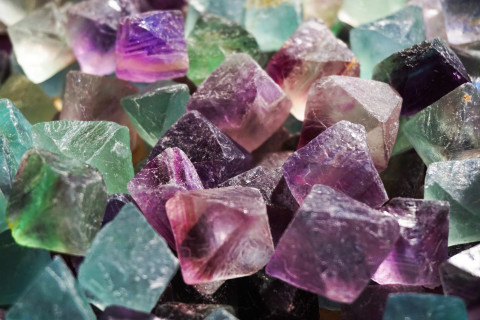EOSC 220 · Introductory Mineralogy

Introduction to crystallography, physical and chemical properties of minerals. Recognition and identification of common minerals.
Syllabus
| Week | Class Discussion Topicsb.(ESB 1012) | Labs (EOSM 127) |
Week1 | Sept 5: Introduction andcourse overview | No Labs |
| Week2 | Sept 10: Minerals Sept 12: Crystallography 1: symmetry | Lab 1: Basic mineral properties |
| Week3 | Sept 17: Crystallography 2: crystal faces, Miller indices, crystal systems Sept 19: Crystal chemistry | Lab 2: Crystallography, habit, mineral formulas |
| Week4 | Sept 26: Crystal structure Sept 28: Substitutions & mineral growth | Lab 3: Native elements, halides, phosphates & sulphides 1 |
| Week5 | Oct 1: Engineers and Geoscientists BC – Careers Oct 3: Properties of minerals | Lab 4: Sulphides 2, oxides & hydroxides |
| Week6 | Oct 8: X-ray crystallography Oct 10: Mineral classification | Lab 5: Carbonates, tungstates & sulphates |
| Week7 | Oct 14 (Mon): Thanksgiving Oct 15: MIDTERM Oct 17: Silicates + tectosilicates 1 | No Labs |
| Week8 | Oct 22: Tectosilicates 2 Oct 24: Phyllosilicates | Lab 6: Lab Midterm; Mystery, danger & beauty in mineralogy |
| Week9 | Oct 29: Inosilicates Oct 31: Sorosilicates + cyclosilicates | Lab 7: Silicates 1: Tectosilicates & phyllosilicates |
| Week10 | Nov 5: Nesosilicates Nov 7: Native elements, sulphides + oxides | Lab 8: Silicates 2: Cyclosilicates & inosilicates |
| Week 11 | Nov 12: Fall Reading Break (Nov 11-13) – no class Nov 14: Carbonates, sulphates + phosphates | No Labs |
| Week12 | Nov 19: Applied mineralogy 1 – cements Nov 21: Optical mineralogy | Lab 9: Silicates 3: Nesosilicates & sorosilicates |
| Week13 | Nov 26: Applied mineralogy 2 – critical metals Nov 28: Mineralogy of the “Deep Earth” | Lab Final |
| Week 14 | Dec 3: Mineral evolution on Planet Earth Dec 5: Final class | No Labs |
Course Content
This course is about investigating the atomic structure and physical properties of common minerals and mineral groups. Together we will develop an understanding of how these features can be used to identify minerals in hand specimens and connect you to the geological resources you use in your everyday lives.
By the end of this course, you will be able to:
- Use atomic structure and crystallography to identify and explain the properties and groupings of common rock-forming minerals.
- Explain correlations between chemical concepts (e.g., substitution, solid solution) and the parts of chemical formulas that control the properties and classification of the major mineral classes on Earth.
- Observe, describe, and measure properties of hand specimens to confidently identify minerals and to place them in groups.
- Evaluate the diversity with geologic time of minerals on Earth, and on other terrestrial planetary bodies, through the concept of “mineral evolution”.
- Develop interpersonal and practical skills useful in future careers by working in groups to evaluate problems and to make decisions.
- Apply mineralogy concepts to broader geological, materials science, analytical, environmental, biological, and economic topics.